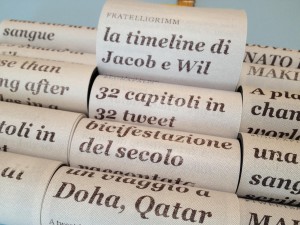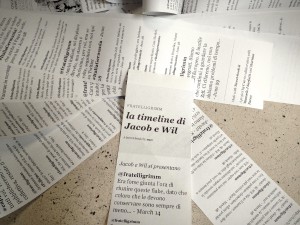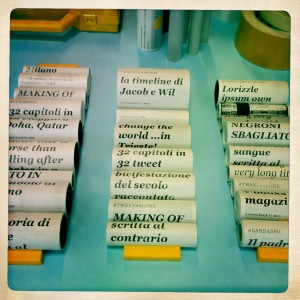U10 is a web publisher and book design studio based in Milan. In this interview Michele Aquila and Valeria Di Rosa will tell about the Tweetbooks they made and the software they are now developing.
Institute of Network Cultures: I can see two different possibilities in the whole project that are in a certain way opposite to each other: the project is both a tool to create content by collecting the tweet stream, and it is also a way to come up with a more conventional and linear format of storytelling, born to be in a book and presented again in the Twitter format.

U10: Yes, it works like that. The software that we are developing together with Martina Facco e Manuele Sarfatti, really helps us a lot in both ways, but it still can’t process the whole system, sometimes we need to work with our own hands – this is because we are still in a very experimental phase and each different project can help us to better understand how to proceed.
We are now working on a project in collaboration with the Italian cultural association doppiozero to write some tales inspired by the “Italian Folktales” by Italo Calvino on Twitter. This time it won’t be a collaborative writing project, Marco Belpoliti will rewrite the tales and we’ll do the entire editorial project, and then the publishing, both online and in a book. Tiziano Bonini, who has already been the consultant for the Brothers Grimm’s project, created the container, a sort of television program. So let’s say that we are working on a kind of broadcasting of some content on Twitter that follows a settled programming. So there will be the opening theme, the daily tale and finally the closure, according to the programming, as it was on television.
It won’t be only a Twitter book. Since the beginning it has been thought as an entertainment format on purpose for being on Twitter: 100 tales will be released in 100 days until the end of March. After that it will become an editorial product too. For now the idea that we have is that we will come out with a product which contains what has been written for the Twitter broadcasting, but we still don’t know whether it will be a container only for the tales or also for the eventual appendices, for instance, all the discussions generated.
INC: I think there are two main issues with the Tweetbooks and the tools to create them, and both are very interesting, concerning a possible new concept for the book: one are all the experiments you are doing on the tools to collect the content on Twitter, so basically the software and the application; on the other hand there is the issue about the output for that content and how it comes to be visualized. So we can start talking about the medium, the book, whether a paper book or a digital one, in a PDF format or in an ePUB one, etc. I’m just wondering, are you also doing some experiments concerning how this content could be depicted for reading and, in general, represented on the medium? How will the whole work come to be visualized?
U10: We’ll show you all the different outputs that have been tested up to now.
INC: During my research I had the opportunity to see many experimental projects on the book as a medium and how the content is represented. One thing I noticed and which I like to focus on, is observing how Twitter triggers a process of indexing: for example, using the hashtags in order to settle down the topics and the stream of tweets. This could be another challenging aspect to work on, still looking at the medium as an output system that can affect the content too. What do you think about Twitter as a system for indexing?
U10: Concerning this, we have noticed that there is another field to explore in which this tool could become a very useful process: the possibility to follow and note down what happens and what is told during a conference in real time, capitalizing on the fact that writing a tweet is something like taking a note. The ones that organize conferences or take part in them really appreciate this kind of service because they can have a complete report of the meeting just 5 minutes since its ending and, in an almost automatic way, make an instant ebook of everything that has been said.
INC: In the making of a digital editorial product there are many different professionals who take part in the process. Which are the ones you interact the most with?
U10: We are structured in this way: U10 is a studio of 2 people, we first created this format and then the software and the application because we started to feel the need for them. We collaborate with graphic designers and developers who we also work with on other projects, mainly web projects, that we make for private institutions or for professionals as a design studio. We decided to start this project together as we had already worked with these people and we knew that we would have get on work with each other in the making of this. Furthermore, sometimes we need to present the project in a more concrete way, according to each situation. We first presented it at the last Salone del Mobile in Milan, after that we have been at the initiative “Pane web e salame 3” in Brescia and then at the Architecture Biennale in Venice. Every time we had to make a real performance as we were on stage. In those cases we used to collaborate also with several designer to give a proper shape to the whole project. Usually we print the Tweetbooks real-time on rolls of paper, almost in a hand-crafted way. However, what I think is still needed is the business plan. For now we are at the experimental phase of the project, but sooner or later it has to become a real product and just stand by itself.
INC: Let’s talk about the editorial market, how do you think this service will work out inside of the market realm?
U10: At the beginning we imagined a basic product, the Freemium format, for basic users that wouldn’t have to pay, then there would have been also some pro users that would pay to have more services, after them the gold users, the partner users and so on. But in April, since we actually started to think from this market perspective, we understood that it will never work like that: we realized that making a Tweetbook it’s a much more demanding job, as you have to select the content and organize it etc.
Actually the most people don’t have enough time to do it by themselves, and so frequently they ask us. So we are now coming up with the idea that, besides the application, probably we will have to provide as well something like an editorial service, an advisory for the making of this kind of publication, and in the future this will be the main job. So yes, in a certain way we will be publishers, as we will provide that kind of service for those who will ask for it, while there will be also several users that will do the Tweetbooks by themselves on their own personal topics without the necessity of our help.
INC: So the users will be the ones that will ask you to realize the Tweetbook, just like it has always been for any publishing project in the curatorial practice, and the ones that will make it by themselves using the software that you are now developing. Will it be open source?
U10: I really would like it to be completely open, but we are now realizing that we are becoming experts in this, and we still have to understand how to deal with both sides, in the making of the Tweetbooks and in the delivery of the software, because there are so many different possibilities that we still haven’t taken into account.
INC: Who did you get in touch with during the different stages of the projects? Did someone interested in the project contact you, and did you get any special request? Did you already get to understand what kind of different users there would be for this service?
U10: We always tackle every possible situation or idea through the people we get in touch with, so if there isn’t anybody who is interested in a particular thing we have first contemplated, that means that it simply won’t work. For example, another feature that we have noticed because of the people we got in touch with is the likely relation with the educational practice for schools and universities.
The first has been the lecturer of the Harvard Extension School – Introduction to Instructional Design class – who wrote by email that she was already using Twitter in her class both as a tool for studying and as a tool for producing content, and she was starting to feel the need for something to collect what her students had done. Secondly, we received another email from a teacher of a middle school of Chieti wondering the same thing, if it was possible to use our application in his class to write something on Twitter and then collect it. The last mail was from IED Istituto Europeo di Design’s Centre for Research who was interested in doing some workshops using Twitter and the Tweetbook into a participatory design process, starting from the brainstorming until the final stages of the project.
Thanks to other relations, we have also realized that if we manage to provide an object too, a concrete thing that one can carry in his pocket or bag – could be a Kindle but also a little roll of paper – people are happier, because they have a physical object that is not only a web page and that could also become a present.
So when we tell the whole project, we say that its operating mode is like the Storify one, but with something more.
INC: In the making of a book choosing to make it digital is always seen as the cheapest way, is it true? Is an ebook cheaper in terms of production than a paper book?
U10: That one is a very common belief, but it is not true. I think that actually the making of a digital book can rather be more expensive, because there is a lot of work to do in the backstage. We had never been involved in the publishing industries before, but according to those who used to live on paper books, it always turns out that making ebooks nowadays lies in the setting up of some new codes to make people understand each other, because suddenly there are many different kinds of professionals who work on it. Furthermore, ebooks are now designed with the same kind of software that has always been used for the paper book, and that’s completely crazy! It’s like using inDesign and force it to do a quite different kind of job.
INC: So do you think that new design softwares to make ebooks are now needed more than ever?
U10: Yes, of course! Our software now provides two ways to make an ebook: one is to use the app and following the usual process, one is to upload handwritten code, and this is like “entering the back door” of the app.
For now we delivered only one default template, designed by our graphic designer Martina Facco, but there could be other 10, 100 or 1000, just like the Instagram’s filters.
The content of the ebook is then created with a code, that works like it was a big Excel worksheet whose paragraphs set a certain behavior. So you just upload the content onto it and then automatically the book is created. The graphic designer first made the template and then the developer found a way to get the content inserted by the users and displayed in the preset layout. That had completely changed our job, because we can now “enter the back door” of the application and make it layout the page, whose design we don’t have to deal with any more.
INC: Maybe we just have to take a small step forward in the idea that we have always had of the book: it’s been a long time since we first started making paper books digitally, although they have always been conceived as something that had to be printed at one step of the process, while all the programming should remain absolutely hidden, as it was something like a taboo. First we might all start to give a different value to the digital way to process a book’s content and see the many possibilities in it. But let’s now imagine making a big jump forward, which one of the paper book’s features will remain in the future?
U10: I do buy paper book, I really like them. Actually I buy both paper book and Kindle’s, according to how I feel.
INC: And what will the paper books look like? Will they look like the ones that we now like to buy, read, handle, because they are just relaxing in their simplicity and affordability? Will the paper book go through some changing too? How will it be after the digital?
U10: I think that Amazon has really flipped the behaviors in the distribution of the book, and so in the way you get to buy it. Maybe this will be the aspect that will be much more extreme in the future … or could it be that the book will look like a little roll of paper, we’ll see!
Special thanks to my colleague Larissa Hildebrandt for the english editing.




